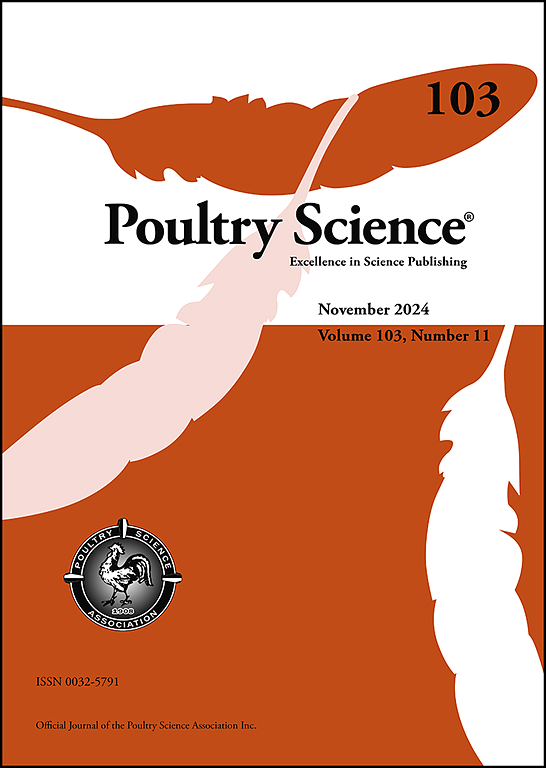Wnt signaling pathway and retinoic acid signaling pathway involved in delamination and migration of chicken trunk NCCs and contributing to HVP phenotype
IF 3.8
1区 农林科学
Q1 AGRICULTURE, DAIRY & ANIMAL SCIENCE
引用次数: 0
Abstract
Hyperpigmentation of the visceral peritoneum (HVP) is a hereditary trait that significantly affects the carcass quality in bearded chickens, yet its molecular mechanisms remain unclear. This study utilized data-independent acquisition proteomics to analyze the protein expression profiles of black peritoneum (B), faded peritoneum (F), and normal peritoneum (N) in bearded chickens at 40 and 120 d of age. Combined with histopathological and functional enrichment analyses, we revealed the regulatory network underlying HVP formation. Results indicated that the melanin content was significantly elevated in HVP samples, without accompanying inflammatory responses or tumor characteristics, suggesting that its formation is driven by developmental abnormalities. A total of 9,375 high-confidence proteins were identified through proteomics, with differentially abundant proteins at 40 d of age (219 proteins) primarily enriched in ribosomal function, tyrosine metabolism, and melanin synthesis pathways. In comparison, at 120 d of age (246 proteins), they were enriched in transcription regulation and chromatin remodeling pathways. The abnormal expression of key co-expressed proteins DHRS3 and DACT1 suggests that the dysregulation of retinoic acid (RA) and the Wnt signaling pathway may promote the directed differentiation of melanocytes by regulating neural crest cells (NCCs). The reduced abundance of the chondroitin sulfate proteoglycan, VCAN, weakened the peritoneal barrier function, whereas estradiol accelerated melanin synthesis via hormonal microenvironmental regulation. Furthermore, the formation of HVP led to a reprogramming of energy metabolism, reduced fat deposition, and a downregulation of immune-related molecules, implying that pigment deposition may weaken the chicken immune response. This study systematically elucidates the molecular mechanisms of HVP and provides potential targets for molecular breeding of HVP.
Wnt信号通路和视黄酸信号通路参与鸡躯干NCC的分层和迁移并导致HVP表型
本文章由计算机程序翻译,如有差异,请以英文原文为准。
求助全文
约1分钟内获得全文
求助全文
来源期刊

Poultry Science
农林科学-奶制品与动物科学
CiteScore
7.60
自引率
15.90%
发文量
0
审稿时长
94 days
期刊介绍:
First self-published in 1921, Poultry Science is an internationally renowned monthly journal, known as the authoritative source for a broad range of poultry information and high-caliber research. The journal plays a pivotal role in the dissemination of preeminent poultry-related knowledge across all disciplines. As of January 2020, Poultry Science will become an Open Access journal with no subscription charges, meaning authors who publish here can make their research immediately, permanently, and freely accessible worldwide while retaining copyright to their work. Papers submitted for publication after October 1, 2019 will be published as Open Access papers.
An international journal, Poultry Science publishes original papers, research notes, symposium papers, and reviews of basic science as applied to poultry. This authoritative source of poultry information is consistently ranked by ISI Impact Factor as one of the top 10 agriculture, dairy and animal science journals to deliver high-caliber research. Currently it is the highest-ranked (by Impact Factor and Eigenfactor) journal dedicated to publishing poultry research. Subject areas include breeding, genetics, education, production, management, environment, health, behavior, welfare, immunology, molecular biology, metabolism, nutrition, physiology, reproduction, processing, and products.
 求助内容:
求助内容: 应助结果提醒方式:
应助结果提醒方式:


